Heterozygosity in the glutathione synthesis gene Gclm increases sensitivity to diesel exhaust particulate induced lung inflammation in mice
- PMID: 21967497
- PMCID: PMC3337699
- DOI: 10.3109/08958378.2011.608095
Heterozygosity in the glutathione synthesis gene Gclm increases sensitivity to diesel exhaust particulate induced lung inflammation in mice
Abstract
Context: Inhalation of ambient fine particulate matter (PM₂.₅) is associated with adverse respiratory and cardiovascular effects. A major fraction of PM₂.₅ in urban settings is diesel exhaust particulate (DEP), and DEP-induced lung inflammation is likely a critical event mediating many of its adverse health effects. Oxidative stress has been proposed to be an important factor in PM₂.₅-induced lung inflammation, and the balance between pro- and antioxidants is an important regulator of this inflammation. An important intracellular antioxidant is the tripeptide thiol glutathione (GSH). Glutamate cysteine ligase (GCL) carries out the first step in GSH synthesis. In humans, relatively common genetic polymorphisms in both the catalytic (Gclc) and modifier (Gclm) subunits of GCL have been associated with increased risk for lung and cardiovascular diseases.
Objective: This study was aimed to determine the effects of Gclm expression on lung inflammation following DEP exposure in mice.
Materials and methods: We exposed Gclm wild type, heterozygous, and null mice to DEP via intranasal instillation and assessed lung inflammation as determined by neutrophils and inflammatory cytokines in lung lavage, inflammatory cytokine mRNA levels in lung tissue, as well as total lung GSH, Gclc, and Gclm protein levels.
Results: The Gclm heterozygosity was associated with a significant increase in DEP-induced lung inflammation when compared to that of wild type mice.
Discussion and conclusion: This finding indicates that GSH synthesis can mediate DEP-induced lung inflammation and suggests that polymorphisms in Gclm may be an important factor in determining adverse health outcomes in humans following inhalation of PM₂.₅.
Figures
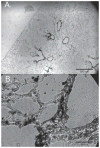

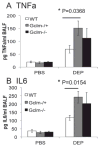
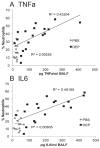
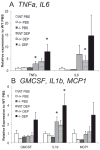
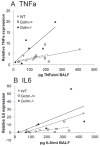
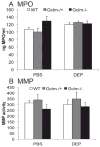


Similar articles
-
Glutathione (GSH) and the GSH synthesis gene Gclm modulate plasma redox and vascular responses to acute diesel exhaust inhalation in mice.Inhal Toxicol. 2013 Jul;25(8):444-54. doi: 10.3109/08958378.2013.801004. Epub 2013 Jul 1. Inhal Toxicol. 2013. PMID: 23808636 Free PMC article.
-
Sex and genetic differences in the effects of acute diesel exhaust exposure on inflammation and oxidative stress in mouse brain.Toxicology. 2016 Dec 30;374:1-9. doi: 10.1016/j.tox.2016.11.010. Epub 2016 Nov 16. Toxicology. 2016. PMID: 27865893 Free PMC article.
-
The glutathione synthesis gene Gclm modulates amphiphilic polymer-coated CdSe/ZnS quantum dot-induced lung inflammation in mice.PLoS One. 2013 May 27;8(5):e64165. doi: 10.1371/journal.pone.0064165. Print 2013. PLoS One. 2013. PMID: 23724032 Free PMC article.
-
Modulating GSH synthesis using glutamate cysteine ligase transgenic and gene-targeted mice.Drug Metab Rev. 2008;40(3):465-77. doi: 10.1080/03602530802186587. Drug Metab Rev. 2008. PMID: 18642143 Review.
-
Diesel exhaust particulate (DEP) and nanoparticle exposures: what do DEP human clinical studies tell us about potential human health hazards of nanoparticles?Inhal Toxicol. 2010 Jul;22(8):679-94. doi: 10.3109/08958371003758823. Inhal Toxicol. 2010. PMID: 20462394 Review.
Cited by
-
Modulation of Pseudomonas aeruginosa Quorum Sensing by Glutathione.J Bacteriol. 2019 Apr 9;201(9):e00685-18. doi: 10.1128/JB.00685-18. Print 2019 May 1. J Bacteriol. 2019. PMID: 30782628 Free PMC article.
-
The effects of genotype × phenotype interactions on silver nanoparticle toxicity in organotypic cultures of murine tracheal epithelial cells.Nanotoxicology. 2020 Sep;14(7):908-928. doi: 10.1080/17435390.2020.1777475. Epub 2020 Jun 23. Nanotoxicology. 2020. PMID: 32574512 Free PMC article.
-
Glutathione (GSH) and the GSH synthesis gene Gclm modulate plasma redox and vascular responses to acute diesel exhaust inhalation in mice.Inhal Toxicol. 2013 Jul;25(8):444-54. doi: 10.3109/08958378.2013.801004. Epub 2013 Jul 1. Inhal Toxicol. 2013. PMID: 23808636 Free PMC article.
-
Polybrominated Diphenyl Ethers and Gut Microbiome Modulate Metabolic Syndrome-Related Aqueous Metabolites in Mice.Drug Metab Dispos. 2019 Aug;47(8):928-940. doi: 10.1124/dmd.119.086538. Epub 2019 May 23. Drug Metab Dispos. 2019. PMID: 31123037 Free PMC article.
-
Systematic review of preclinical studies on the neutrophil-mediated immune response to air pollutants, 1980-2020.Heliyon. 2022 Jan 25;8(1):e08778. doi: 10.1016/j.heliyon.2022.e08778. eCollection 2022 Jan. Heliyon. 2022. PMID: 35128092 Free PMC article. Review.
References
-
- Banerjee A, Trueblood MB, Zhang X, Manda KR, Lobo P, Whitefield PD, Hagen DE, Ercal N. N-acetylcysteineamide (NACA) prevents inflammation and oxidative stress in animals exposed to diesel engine exhaust. Toxicol Lett. 2009;187:187–193. - PubMed
-
- Bea F, Hudson FN, Chait A, Kavanagh TJ, Rosenfeld ME. Induction of glutathione synthesis in macrophages by oxidized low-density lipoproteins is mediated by consensus antioxidant response elements. Circ Res. 2003;92:386–393. - PubMed
-
- Botta D, White CC, Vliet-Gregg P, Mohar I, Shi S, McGrath MB, McConnachie LA, Kavanagh TJ. Modulating GSH synthesis using glutamate cysteine ligase transgenic and gene-targeted mice. Drug Metab Rev. 2008;40:465–477. - PubMed
-
- Chappell S, Daly L, Morgan K, Guetta-Baranes T, Roca J, Rabinovich R, Lotya J, Millar AB, Donnelly SC, Keatings V, MacNee W, Stolk J, Hiemstra PS, Miniati M, Monti S, O’Connor CM, Kalsheker N. Genetic variants of microsomal epoxide hydrolase and glutamate-cysteine ligase in COPD. Eur Respir J. 2008;32:931–937. - PubMed
Publication types
MeSH terms
Substances
Grants and funding
LinkOut - more resources
Full Text Sources
Medical
Research Materials
Miscellaneous
